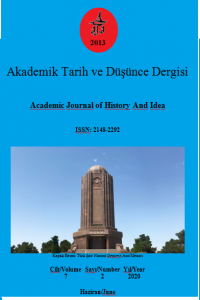I. Dareios’un İskit Seferinin Nedenleri Üzerine
I. Dareios, Herodotos, İskit, Pers
Upon the Reasons of I.Dareious’s Scytian Expedition
___
- BALCER, J. M.,(1972). “The Date of Herodotus IV.1 Darius’ Scythian Expedition” HSCP 76, s. 99–132. BALCER, J. M., (1984). Sparda By The Bitter Sea: Imperial Interaction in Western Anatolia, Chico. BALCER, J. M., (1995). The Persian Conquest of the Greeks, Universitätsverlag, Konstanz. BURN, A.R., (1984). Persia and the Greeks: of Darius” Classical Review 11, no. 6, s. 277–282. DANDAMAEV, M. A., (1989). A Political History of the Achaemenid Empire (English translation) Leiden, New York, Kobenhagen, Köln. DREWS, R., (1973). The Greek Accounts of Eastern History, Cambridge: Harvard University Press. DURMUŞ, İ., “Anadolu’da Kimmerler ve İskitler”, Belleten, Cilt LXI, TTK, Ankara, Ağustos 1997, s. 273-286. FGrH, F. Jacoby, (1958), Die Fragmente der griechischen Historiker, Dritter Teil C, Erster Band, Leiden. GARDİNER-GARDEN, J.R., (1983). “Dareios’ Scythian Expedition and its Aftermath”, Klio 69, No. 2, s. 326–350. GRAKOV, B. N., (2006). İskitler, Çev. Ahsen Batur, Selenge Yayınevi, İstanbul. HARMATTA, J., (1976). “Darius' expedition against the Saka Tigraxauda”, Antique Antiqua, XXIV, pp. 15-24. HİGNETT, C., (1963). Xerxes Invasion of Greece, Clarendon Press, Oxford. HODDİNOTT, R. F., (1981). The Thracians, Thames and Hudson, New York. HSCP, Harvard Studies in Classical Philology. KENT, R. G., (1950), Old Persian Grammer: Texts, Lexicon, American Oriental Society. New Haven, Connecticut. KLİNKOTT, H. (2005). Ein achaimenidischer Amtsträger und seine Handlungsspielräume, Verlag Antike, Frankfurt/Main. Klio, Beiträge zur Alten Geschichte, (1959).Leipzig andWiesbaden 1902-44. KUHRT, A., (2007). The Persian Empire: A Corpus of Sources of the Achaemenid Period, Vol. I. London. OLMSTEAD, A. T., (1948). History of the Persian Empire, University of Chicago Press, Chicago. RE, Paulys Real-Encyclopadie der klassischen Altertumswissenschaft. ROLLE, R., (1980). Die Welt der Skythen: Stutenmelker und Pferdebogner: ein antikes Reitervolk in neuer Sicht, Luzern and Frankfurt. ROMM, J., (1998). Herodotus, Yale University Press, New Haven and London. ROSTOVTZEFF, M., (1922). Iranians and Greeks in South Russia, Oxford at the Clarendon Press. RUGE, W., (1922). “Kyaneiai”, RE XI. 2, 2236.
- Yayın Aralığı: Yılda 6 Sayı
- Başlangıç: 2013
- Yayıncı: Hakan YILMAZ
Modern Dilbilim Terimlerinin Rusça Karşılıkları
Kamil Veli NERİMANOĞLU, İrina GÜNAY, Gencer GENÇOĞLU, Asude ÖZCAN
Gelibolulu Mustafa ‘Âlî’nin Mirâtü’l Avâlim İsimli Eseri
Başarısız Bir Pan-Milliyetçilik Girişimi: Birleşik Arap Cumhuriyeti
Kenan ŞAHİN, Çağla Mavruk CAVLAK
Mahatma Gandhi ve Sessiz Direnişi
Geçmişten Günümüze Münâfıkların Değişmeyen Karakteri (Kur’ân-ı Kerîm’deki Nitelikler)
Yedinci Dönem TBMM’de Dokunulmazlık Tezkereleri (1943-1946)
Arslan Argun İsyanına Farklı Bir Bakış
Varlığın Ötesi: Heidegger’in Platon’u
Bulgaristan’da Rekabet Eden Tarih Yazımlarının Mekansal Görünümleri
Kutup Şahi Hanedanlığı’nın Başkenti Golkonda’da Fars Dili Ve Edebiyatı
